RoboRally is 20 years old this year. It remains one of my favorite boardgames of all time: The combination of clever puzzle-solving, long-term strategic thinking, and half-crazed chaos is brilliantly balanced. I wrote a detailed review of the original edition of the game back in 1998.
One of the things I always wanted to do back in the day was pick up the three expansions that were released in the ’90s: Armed & Dangerous, Radioactive, Crash & Burn, and Grand Prix. Unfortunately, I was a poor high school / college student back then and I couldn’t afford to snap them up when they were released. Then, with the release of the second edition of the game, the expansions were taken out of print and immediately skyrocketed in price.
Last year, however, I decided to bite the bullet and track down all of the expansions for the game.
I also picked up a copy of the 3rd Edition published under the Avalon Hill brand in 2005: This edition replaced the metal miniatures with plastic ones and used much cheaper stock for the map boards, but significantly upgraded many of the other components. (I’m particularly enamored of the plastic flags.)
Once I had this mass of material, however, it took a little extra effort to figure out how to combine all of it together for the RoboRally: Utimate Collection. So I’d like to take a moment to share that effort with all of you. (And some of what I’ve done I think you’ll find useful even if you aren’t interested in owning an Ultimate Collection of your own.)
ASSEMBLING THE ULTIMATE COLLECTION
In order to assemble the RoboRally Ultimate Collection, you’ll need to buy:
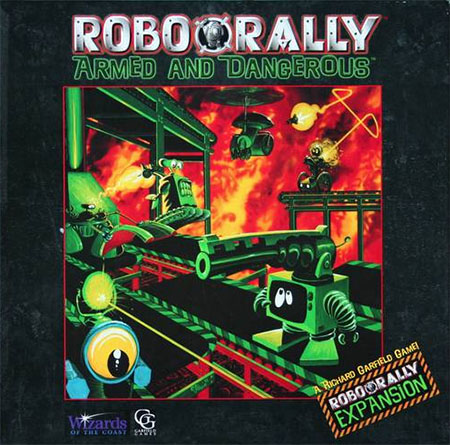 RoboRally (1st Edition)
RoboRally (1st Edition)- RoboRally (2nd Edition)
- RoboRally (3rd Edition)
- RoboRally: Armed and Dangerous
- RoboRally: Radioactive
- RoboRally: Crash & Burn
- RoboRally: Grand Prix
You will then collect from these editions:
ROBOTS: You’ll be able to use the robots from all three editions of the game (giving you a total of 24 different robots). Some of the robot models from the 1st Edition are replicated in 2nd Edition (and Twonky appears in all three editions, albeit with different sculpts). Simply paint the duplicates different colors. You’ll also want to take the Archive markers from all three editions.
GAME BOARDS: Take the game boards from the 1st Edition and 3rd Edition of the game. Then take all of the game boards from the expansions (Armed and Dangerous, Radioactive, Crash & Burn, and Grand Prix).
PROGRAM CARDS: I personally prefer the program cards from 3rd Edition.
OPTION CARDS / TOKENS: You’ll want to use the Option cards from the 1st Edition of the game and combine them with the Option cards from Armed and Dangerous. Take the option tokens from Armed and Dangerous.
FLAGS: 1st Edition used red flag chits. 2nd Edition used green flag chits. 3rd Edition uses plastic flags that stand up from the game board. The plastic flags from 3rd Edition are clearly superior, but you can actually pull the flags from all three editions if you want to run some truly insane rallies. (For example, you could run through the plastic flags, then the red flags, and then the green flags for an insane course featuring 24 rally points. Put them all on a single game board for sheer insanity.)
MISC. COMPONENTS: Take the damage tokens, Power Down tokens, and life tokens from the 3rd Edition of the game. (You’ll want to use the 3rd edition components to match the program sheets.) Also take the thirty-second timer from the 3rd Edition.
And that’s it! The tricky part these days is actually finding all of the original 1st Edition expansion sets.
ULTIMATE COLLECTION RULEBOOK
In order to wed the disparate components from across multiple editions together, I’ve also prepared the RoboRally Ultimate Collection Rulebook and the RoboRally Ultimate Collection Factory Guide. The latter pulls together the information from all of the different board element guides into a handy reference guide that you can print on a single sheet of paper. The former provides the most authoritative version of the complete RoboRally rules ever produced.
In fact, whether you can (or want) to assemble a full Ultimate Collection, I think you’ll still want to check out the Ultimate Collection Rulebook: It reorganizes and streamlines the rules while simultaneously clarifying them in order to resolve a number of vague corner-cases that none of the official rulebooks can handle properly.

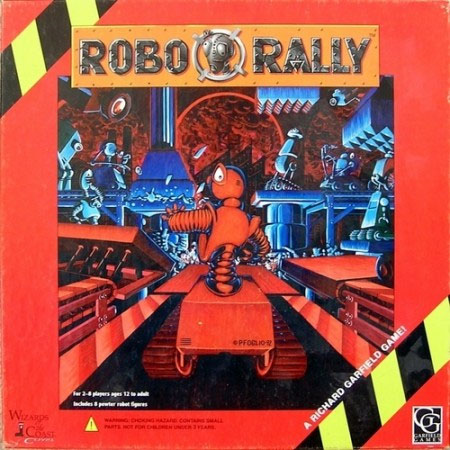
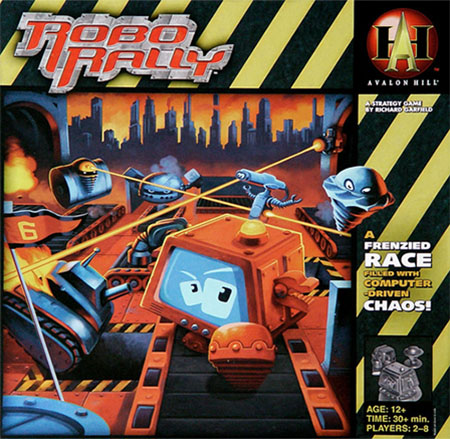
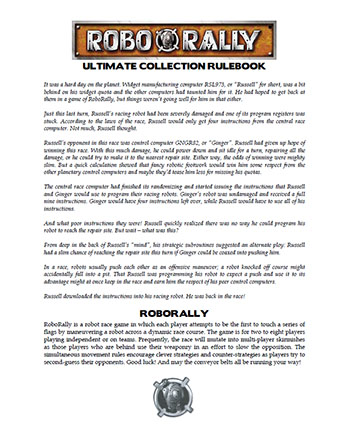
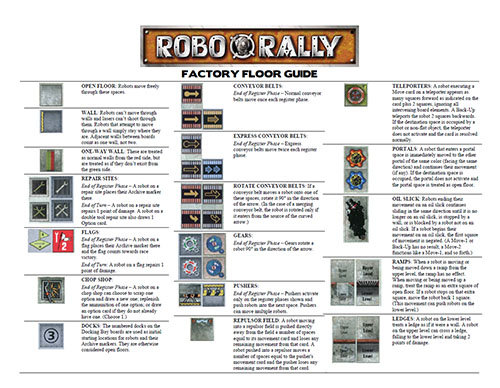











Wow. Very well done. Lots of good memories of Robo Rally games, this looks especially epic.
Thank you for compiling this ultimate collection rulebook and factory guide. I recently purchased RoboRally 3rd edition without even realizing there were ever expansions to prior versions. Once I realized there was more to this game than the 26 option cards and 4 2-sided boards that come in the box, I started downloading everything I could to make print&play substitutes for the nearly-impossible-to-find expansions so I could construct my own ultimate RoboRally set. This will help considerably. Great work!
HI,
I was interested in why you take the boards from v1 and v3 rather than v2. And why you prefer the v3 program cards?
Thanks
DoctorMike
The v1 and v2 boards are essentially identical. (The content is definitely identical, and IIRC the production quality is also the same.)
The content of the Program Cards are identical across all editions. I just prefer the graphic design of the v3 cards.
That’s interesting, as I thought the v1 boards much darker than v2, despite being identical in other respects, but don’t the v3 program cards not have the number in the same place in the corners? The v1 cards didn’t have this at all, making checks of cards require looking at the full card. v2 cards allow you to see what you have by glancing at the corners, like regular playing cards. However, the v3 cards require you to fan much wider to see your hand; the mini icons are further in from the edge. That is why the v2 game is the ultimate single set IMHO.
+1 to Dr. Mike Reddy.
v2 is the ultimate single set. I own v1 and v2, plus the four expansions. My preferred setup is to keep all the boards in the v2 game box. The robots and various cardboard chits go in a small clear plastic tackle box in the Armed and Dangerous game box, along with the rules, program cards, and option cards. This keeps my rarer first edition intact.
I don’t own v3, but from what I’ve seen, the only parts that I prefer from it are the flags. Well, I do like the fact that the express conveyors have two arrows on them, but there is not much I can do about that, unless I find some print-and-play boards, or print my own. But this is a very minor quibble.
Note you’ve left off the two boxes sets of the European series. They come with 8 more (different) robots, as well as markers you can use to move board elements around. The movement cards are also color-coded.
So you’re not done yet!
The 2e cards are generally superior, as they indicate in the upper corner what type of card they are. 3e removed that, making it harder to fan out the cards in your hand and know what you have.
The problem with the 3e flags is they cover the walls (and are vaguely yellow, so mask the yellow walls even more. The A&D flags are smaller than the squares, and stand out better.
I have only known 1st and 2nd edition, Armed and Dangerous, Crash and Burn, and Radioactive. Since I first played this game, back when it was first on the shelves, I have been a fan of it. Every time it is played, it is different. It is a fun way to teach someone to make the best of what they have as well as humility because even the best plans can backfire. It is too bad that this great game is no longer being expanded.
You can also spice up your games by using minitures from other games so long as you can clearly tell which direction is forward. For example, use a Space Marine instead of a robot. Have fun!
Do you have any idea where I might sell a 1st Edition that has never been opened?